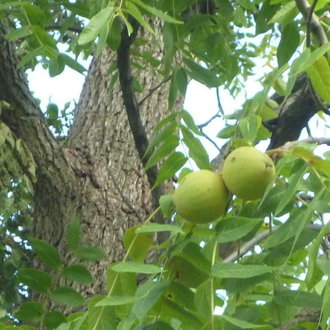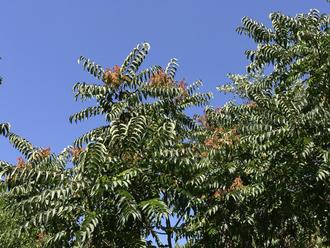Tree of Heaven (Ailanthus altissima (Mill.) Swingle)
Also classified as Ailanthus altissimus (Alternate Ending).
↑Summary
A fast-growing tree, native to east Asia, and widely introduced across North America. Common in anthropogenic habitats in much of its introduced range, less common in natural areas.
↑Range - Expand
| Legend | Color |
| Introduced | |
| Introduced or Not Present |
This tentative map is based on our own research. It may have limited data on Canada and/or Mexico, and there is some subjectivity in our assignment of plants as introduced vs. expanded. Read more in this blog post.
Although this plant occurs somewhere in each of these regions, it may only occur in a small part of some or all of them.
↑Similar Plants
↑Habitat
In its native range, this species is found in a wide range of conditions, but prefers moist, loamy soils, especially those derived from limestone.
In North America, found in a wide range of habitats and climate zones, primarily in anthropogenic habitats, including poorly-maintained properties in cities, along roadsides, railroads, and on vacant lots and waste ground. Also found on former strip mining sites. In wild forests, usually only found as scattered individiuals that have established following disturbances.
Although this plant is now found continent-wide, its habitats and abundance vary regionally. It is most abundant and invasive from mid-to-southern New England, south to the mid-Atlantic. It is widespread, but not quite as invasive, in the lower parts of the Midwest, especially Ohio and Indiana. It is slightly less invasive in the mid-to-southern great plains, and the southeast. In the Pacific Northwest, it primarily occurs along waterways, and in the southwest it is primarily found in riparian areas and canyons.
Prefers full sun and moist conditions, but tolerates some shade and significant drought; able to survive on moister sites in arid climates. Tolerates air pollution, especially from sulfur dioxide, and most industrial pollutants, but intolerant of ground-level ozone. Intolerant of heavy competition for light from other plants, but often able to outcompete other plants through allelopathy and rapid growth.
Prefers moist, loamy soils textures, and tolerates rocky soils. Has low phosphorus needs and often is highly competetive on low-phosphorus sites. In North America, less common on calcareous and high pH soils, and usually found on ultisols, inceptisols, and entisols.
↑Life Cycle
Tree of Heaven is a fast-growing, short-lived tree that often reproduces vegetatively.
Seeds germinate on the soil surface; leaf litter from oaks seems to inhibit survival. The seeds are relatively large among wind-dispersed seeds, and tend to be larger in the north, allowing seedlings to establish quickly, but seedlings still have high light needs and fail to establish on shaded sites. Seedlings grow rapidly, averaging 1.3 feet annually in the first few years, with growth accelerating.
Growth is among the most rapid of any tree in North America. Trees may reach heights of 80 feet in as little as 10 years.
Male and female flowers are borne on separate individuals. Seed production tends to peak around 12-20 years of age.
Trees frequently reproduce vegetatively, sending up new shoots from root sprouts. Root sprouting is most common and abundant when one or more trunks of a plant have been top-killed, but it can occur in the absence of top-kill, when the tree's root system reaches a new site with sufficient light. Shoots from root sprouts grow much faster than seedlings, often averaging 2.7 feet growth in the first few years, and in extreme cases growth rates of sprouts up to 13 feet in the first year have been measured. Individuals can cover an area of up to 1 acre with multiple trunks.
Individual trunks are short-lived, typically 30-70 years. However, on favorable sites, an individual's root system can live hundreds of years, sending up new sprouts. In the north of its range, as well as at higher elevations, cold temperatures in winter can cause mortality, although the root system is much better able to survive cold, and top-killed trees often resprout. In forests on richer sites, Ailanthus cannot survive long-term competition from more shade-tolerant species such as oak and maple, and plants will eventually be shut out, as trunks die and resprouts are unable to survive in the lower-light environment. Trees can also be killed by Verticillium wilt, often following infestation by insects and/or mites.
↑Faunal Associations
This species has complex relationships to wildlife, in some instances supporting native wildlife but also supporting invasive animal species that have significant detrimental effects on ecosystems in North America.
White-tailed deer and domestic goats both browse the foliage, but it is not a preferred food source to either; most ungulates ignore this species due to toxic compounds. The avoidance of this species by mammalian herbivores can lead it to dominate in areas with deer overbrowsing, hindering the establishment of more shade-tolerant vegetation and thus lowering total biodiversity. However meadow voles browse seedlings, may even prefer them. The seeds are eaten sparingly by birds in the northern portion of its range, including pine grosbeak and crossbills, but are largely ignored by mammals.
In North America, this species is eaten by the Ailanthus webworm moth (Atteva aurea), a species native to central America and southern Florida that originally ate paradisetree (Simarouba glauca), and jumped host to eat this plant and then expanded its range northward. The ailanthus silkmoth or eri silkmoth (Samia cynthia), which is introduced from East Asia, also eats the foliage. The foliage is also occasionally eaten by several generalist species, including the fall webworm (Hyphantria cunea) and the white-marked tussock moth (Orgyia leucostigma), and the bagworm moth Oiketicus toumeyi. It has been reported being eaten by the cecropia moth (Hyalophora cecropia), but is probably not a preferred or important food source for that species. In the south of its range it is also eaten by the generalist Rothschildia jorulla and the uncommon Rothschildia lebeau.
The tree's sap is a preferred food of the spotted lanternfly (Lycorma delicatula) in one of its life stages, which has lead to an increased push to remove this species to curb the spread of that invasive insect. The tree also has extrafloral nectaries that attract and support ants, which may protect the tree against other insects. Ants also sometimes build nests in holes in older, rotting trees.
The leaf litter, which decays more rapidly than that of most native species, is often actively preferred by isopods and caddisflies. The litter is also preferred by the introduced earthworm Lumbricus terrestris, which is considered invasive in North America.
↑Control
Ailanthus is usually relatively easy to keep out of an area if the area is monitored regularly, but can be difficult to remove once established.
Young seedlings can be easily pulled by hand. Saplings can also be uprooted, but care must be taken to remove all the root on larger individuals, because this species can resprout from small pieces of root.
Mature trees, especially when they occur in large stands, are difficult to control due to their strong resprouting ability and ability to reproduce vegetatively. Repeated control attempts over multiple years are often necessary for full removal. Cutting mature trees will often result in prolific resprouting. The most effective control of mature trees involves a combination of herbicide and cutting, usually the application of herbicide in mid to late summer, followed by cutting a month later. Waiting till later in the season is important to maximize transport of the herbicide into the roots; earlier applications are less likely to reach the roots and will often result in top-kill only. Time is necessary after application in order to maximize transport into the roots.
Ailanthus is susceptible to many herbicides, including dicamba, glyphosate, imazapyr, metsulfuron methyl, and triclopyr. Glyphosate or triclopyr are usually the best choices because they have almost no activity in the soil and thus minimize harm to other plants. An even more effective method for minimizing damage to other plants is to place cuts around the stem, with intact bark between cuts, and then apply herbicides to the cuts.
Once it is removed, establishment of native trees can prevent reestablishment. Seedlings cannot usually establish under a closed canopy, and resprouts can also be killed if sufficiently shaded.
↑Uses
Historically, this species was widely planted as a landscaping plant, where it was valued for its rapid growth and showy blossoms and seedheads. Now it is mostly considered a weed and invasive plant, and is rarely planted.
This is one of many species used to produce a nonstandard type of silk, called Eri silk, stronger and cheaper than the silk produced from mulberry leaves.
It can also be used for its wood, which has many desirable qualities, although it requires special techniques to dry it without cracking.
The plant is also used in Chinese traditional medicine and has also been studied in modern medical treatments.
↑Related Plants
There are several other Ailanthus species worldwide, but none of them are found in North America. The broader Simaroubaceae family, however, contains many other genera. None of these are particularly closely related, with Ailanthus probably having split off from the rest of the family than the other genera, which are more related to each other.
Of the genera in the same family, four species from three genera occur in North America, all of which are native. These include crucifixion thorn (Castela emoryi) in the southwest, goatbush (Castela erecta) in south Texas, corkwood (Leitneria floridana) in the central US through Florida, and paradisetree (Simarouba glauca) in south Florida.
↑Links & External Resources
• Ailanthus | The Wood Database (About This Site)
• Tree-of-Heaven | Fire Effects Information System (FEIS) (About This Site)
• Ailanthus altissima (Tree-of-Heaven) | Illinois Wildflowers (About This Site)
• Ailanthus altissima (Tree of Heaven) | USDA PLANTS Database (About This Site)
• Ailanthus altissima | Go Botany (About This Site)
• Ailanthus altissima (Tree of Heaven) | Missouri Botanical Garden Plant Finder (About This Site)
• Tree-of-Heaven | Virginia Tech Dendrology Factsheets (About This Site)
• Ailanthus | Silvics of North America (About This Site)
• Ailanthus altissima | Biota of North America Project (BONAP) (About This Site)
• Ailanthus altissima | NatureServe Explorer (About This Site)
• Ailanthus altissimus | Missouri Plants (About This Site)
• Tree of Heaven | Maryland Biodiversity Project (About This Site)
• Ailanthus altissima (P. Miller) Swingle (Tree-of-heaven) | Digital Atlas of the Virginia Flora (About This Site)

















